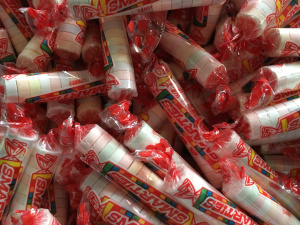
Smarties come in six flavors: white (orange crème), yellow (pineapple), pink (cherry), green (strawberry), purple (grape), and orange (orange). Smarties are gluten free and vegan and have 25 calories per roll of 15 candies. The main ingredient in Smarties is dextrose, a form of sugar.The Smarties Candy Company, founded in 1949, makes its Smarties candy in a New Jersey plant. Its founder bought gunpowder pellet machines after World War I and repurposed them to make the tablet-shaped candies. Smarties are made by color in large batches and then dumped together to be sorted by machines into rolls and packs.
Three granddaughters of the original founder of Smarties now run the company and have been working to improve efficiency. Their chief mechanic designed a faster candy press and a new wrapper machine. Previously, 125 Smarties rolls could be wrapped per minute; now 200 rolls can be wrapped per minute.
Smarties are produced 24 hours a day. (You can
see a short video clip about Smarties and the production process at
http://www.fyi.tv/shows/food-factory-usa/videos/these-women-have-business-smarties
.)
The Smarties Candy Company has its one main product that is likely
to account for most of its sales, but recently it has introduced
Smarties ‘n creme, which are tablets that are about the size of a
quarter and have a flavor burst that is half fruit (strawberry,
blueberry, raspberry, peach, or orange) and half cream
(dairy-free.)
Questions
- Give an example of each of the following types of costs at the
Smarties Candy Company:
- Direct material
- Direct labor
- Manufacturing overhead
- Selling and administrative expense
- Assume that only Smarties candies are made in the New Jersey plant. Do you think the Smarties Candy Company is likely to use job order costing or process costing? Explain.
- If the New Jersey plant begins to produce Smarties ‘n creme in addition to Smarties candy rolls, would this change be likely to whether the company uses job order costing or process costing? Why or why not?

